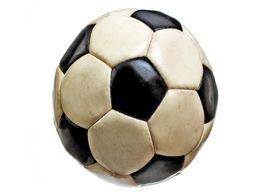
July 02, 2014

Source: Shutterstock
Like rugby, American gridiron football, and Australian Rules football, soccer evolved out of medieval mob football, typically fought out between villages, with cursory rules and unlimited numbers of combatants. In the English town of Ashbourne in Derbyshire, the two-day Royal Shrovetide Football game, also known as “hugball,” has been played annually in the streets at least since the 1660s. Native-born sons of two neighborhoods, the Up’Ards v. the Down’Ards, do battle. The action resembles a cross between a rugby scrum, a bench-clearing brawl during a baseball game, and a mass migration as the hundreds of players try to push the ball to goals three miles apart.
People all over the world have played local games since time immemorial, but the development of the British railway grid in Britain in the 19th century made games feasible between posh English public schools. The schools had to get together to argue over rules and eventually write them down, an institution-building process that rail travel also encouraged. The rules of American football, for instance, were hashed out at annual postseason conventions at railroad station hotels.
The style of football developed at Rugby under schoolmaster Thomas Arnold, the hero of the didactic novel Tom Brown’s Schooldays, emphasized carrying the ball. In 1863 the Football Association of clubs and public schools, under the leadership of Cambridge University, endorsed the kicking rules of Charterhouse school. In December of that year, the proponents of Rugby-style football walked out, and both association football, or soccer, and rugby, or rugger, were born.
Then, FIFA.com explains:
The spread of football [soccer] outside of Great Britain, mainly due to the British influence abroad, started slowly, but it soon gathered momentum and rapidly reached all parts of the world. The next countries to form football associations after the Netherlands and Denmark in 1889 were New Zealand (1891), Argentina (1893), Chile (1895), Switzerland, Belgium (1895), Italy (1898), Germany, Uruguay (both in 1900), Hungary (1901) and Finland (1907).
A Victorian culture emphasizing fair play and sportsmanship, along with a high degree of national homogeneity, helped the British elites cooperate over rules without worrying too much that the others were conspiring to do them down.
Victorian British team sports such as soccer, rugby, and cricket (not to mention individual games such as lawn tennis, golf, and thoroughbred horse racing) unfurled to much of the world. Sports, in general, were promoted internationally by Anglophiles, such as Baron Pierre de Coubertin, the French founder of the modern Olympics, who was deeply inspired by his visit to Rugby.
The chief holdouts against British sports imperialism were the other Anglosphere lands, whose similar cultures allowed them to develop their own games, such as ice hockey in Canada, Australian Rules football in the antipodes, and baseball, football, and basketball in America. Even volleyball, a sport today popular in Brazil, Cuba, and the European continent, is as WASPy in origins as is imaginable: William G. Morgan invented it in 1895 at the YMCA in Holyoke, Massachusetts in response to his friend James Naismith inventing basketball at the Springfield YMCA four years before.
This is not to say that non-Anglophones can”t come up with a good team sport. Maybe the WASPs just got there first.
On the other hand, there isn”t all that much evidence they can. For example, during a Summer Olympics, try watching team handball, a Teutonic-Nordic concoction whose rules were first published in 1906. On paper, team handball sounds promising: it’s kind of like soccer, but uses human beings” more competent appendages; it’s kind of like basketball, but you don”t have to have to be absurdly tall. Yet you”ll see that it deserves its lack of popularity. Every Olympics, I tune in expecting that the team handball authorities have finally solved their obvious problems, but I never notice any improvement.
Contra Beinart, American sports fans were more cosmopolitan in the 1960s and 1970s, when a Nielsen ratings powerhouse was ABC’s internationally-oriented Wide World of Sports, or as Cheech and Chong called it, “ABC’s White World of Sports.” Similarly, strange as it may seem today, Sports Illustrated dispatched fine writers to cover European auto racing, Canadian logrolling, and Argentinean soccer.
What happened? Why are contemporary American sports fans so much more xenophobic than past generations? Perhaps the biggest change has been the rise of African-American athletes in football and basketball and the accompanying assumption among American sports fans, which reached full bloom with Michael Jordan’s Dream Team at the 1992 Olympics, that it’s not a real sport unless it’s dominated by blacks.